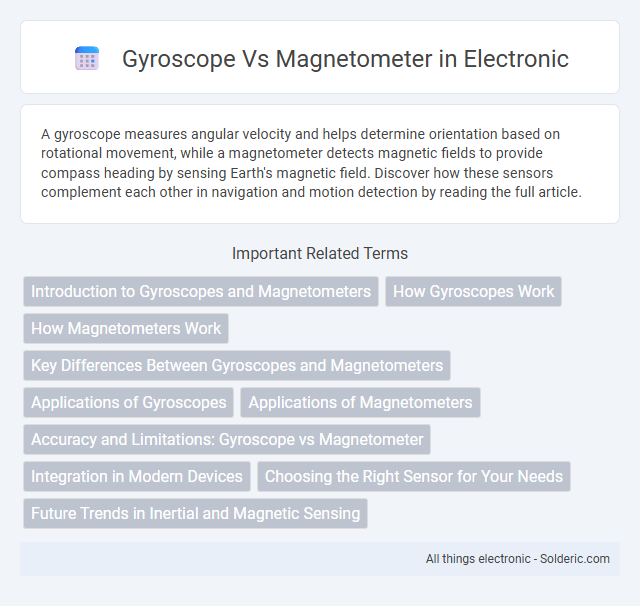A gyroscope measures angular velocity and helps determine orientation based on rotational movement, while a magnetometer detects magnetic fields to provide compass heading by sensing Earth's magnetic field. Discover how these sensors complement each other in navigation and motion detection by reading the full article.
Comparison Table
| Feature | Gyroscope | Magnetometer |
|---|---|---|
| Purpose | Measures angular velocity and orientation | Measures magnetic field strength and direction |
| Measurement Type | Rotation rate (degrees/sec or radians/sec) | Magnetic flux density (microteslas, uT) |
| Sensor Output | Angular velocity data | Magnetic field vector |
| Use Cases | Navigation, motion tracking, stabilization | Compass heading, metal detection, orientation |
| Environmental Influence | Unaffected by magnetic fields | Susceptible to electromagnetic interference |
| Drift | Prone to drift over time without calibration | Generally stable but affected by local magnetic anomalies |
| Typical Applications | Smartphones, drones, VR controllers | Digital compasses, smartphones, navigation systems |
| Output Frequency | High frequency (up to kHz range) | Lower frequency (tens to hundreds Hz) |
Introduction to Gyroscopes and Magnetometers
Gyroscopes measure angular velocity by detecting rotational motion through spinning mass or vibrating elements, making them essential in navigation and stabilization systems. Magnetometers sense magnetic fields and are widely used for orientation by detecting Earth's magnetic field, functioning as electronic compasses in smartphones and drones. Both sensors complement each other in inertial measurement units (IMUs) to provide accurate spatial awareness and navigation data.
How Gyroscopes Work
Gyroscopes measure angular velocity using a spinning rotor or vibrating element that maintains orientation based on the principle of angular momentum. This sensor detects rotational motion by sensing changes in the rotor's position relative to an inertial frame, enabling precise tracking of changes in direction or orientation. Your devices rely on these sensors to provide stability, navigation, and motion-sensing capabilities essential for applications like smartphones, drones, and gaming controllers.
How Magnetometers Work
Magnetometers measure the strength and direction of magnetic fields using magnetic sensors such as Hall effect sensors or fluxgate sensors. These devices detect changes in the Earth's magnetic field to determine orientation relative to magnetic north. Your device relies on this data to provide accurate compass readings and enhance navigation accuracy.
Key Differences Between Gyroscopes and Magnetometers
Gyroscopes measure angular velocity to detect rotational motion, while magnetometers measure magnetic fields to determine orientation relative to the Earth's magnetic field. Gyroscopes provide precise short-term rotational tracking but can suffer from drift over time, whereas magnetometers offer absolute heading information but are susceptible to magnetic interference. Combining both sensors in inertial measurement units (IMUs) enhances overall accuracy for navigation and motion sensing applications.
Applications of Gyroscopes
Gyroscopes play a critical role in navigation systems for aircraft, spacecraft, and ships by providing precise orientation and angular velocity data. They are essential in smartphone motion sensing, virtual reality devices, and camera stabilization to ensure accurate movement tracking and image steadiness. In robotics and autonomous vehicles, gyroscopes enable balance control and accurate heading information, enhancing operational efficiency and safety.
Applications of Magnetometers
Magnetometers are widely used in navigation systems, such as smartphones and aircraft, to measure the Earth's magnetic field for accurate compass orientation. They play a crucial role in geological surveys, detecting mineral deposits and monitoring volcanic activity. Your smartphone relies on magnetometers to enhance GPS accuracy by providing directional data that complements gyroscope sensor inputs.
Accuracy and Limitations: Gyroscope vs Magnetometer
Gyroscopes provide high accuracy in detecting angular velocity and orientation changes but can suffer from drift over time, requiring periodic calibration. Magnetometers accurately measure magnetic fields for heading information but are susceptible to interference from nearby metal objects and electromagnetic noise, which can lead to distorted readings. Your choice depends on whether you prioritize precision in rotational movement (gyroscope) or reliable directional heading relative to Earth's magnetic field (magnetometer).
Integration in Modern Devices
Gyroscopes and magnetometers are integral sensors in modern devices, enhancing orientation and navigation capabilities. Gyroscopes measure angular velocity, providing precise rotational data used in smartphones, drones, and VR headsets for stable motion tracking. Magnetometers detect magnetic fields, enabling compass functionality by determining device direction relative to Earth's magnetic poles, crucial for GPS navigation and augmented reality applications.
Choosing the Right Sensor for Your Needs
Gyroscopes measure angular velocity, providing precise orientation and rotation data essential for applications like drone stabilization and motion tracking, while magnetometers detect magnetic fields to determine absolute heading relative to the Earth's magnetic field, crucial for compass-based navigation. Choosing the right sensor depends on whether your focus is on tracking rotational movement or obtaining directional information within your environment. Your decision should consider factors such as accuracy requirements, environmental conditions, and the specific functionalities needed for your project.
Future Trends in Inertial and Magnetic Sensing
Future trends in inertial and magnetic sensing emphasize the integration of gyroscope and magnetometer technologies to enhance accuracy and reliability in navigation systems. Advances in microelectromechanical systems (MEMS) are driving smaller, more energy-efficient sensors capable of real-time data fusion for autonomous vehicles and wearable devices. Artificial intelligence algorithms increasingly optimize sensor calibration and error correction, pushing the boundaries of precise orientation and magnetic field detection.
gyroscope vs magnetometer Infographic

 solderic.com
solderic.com